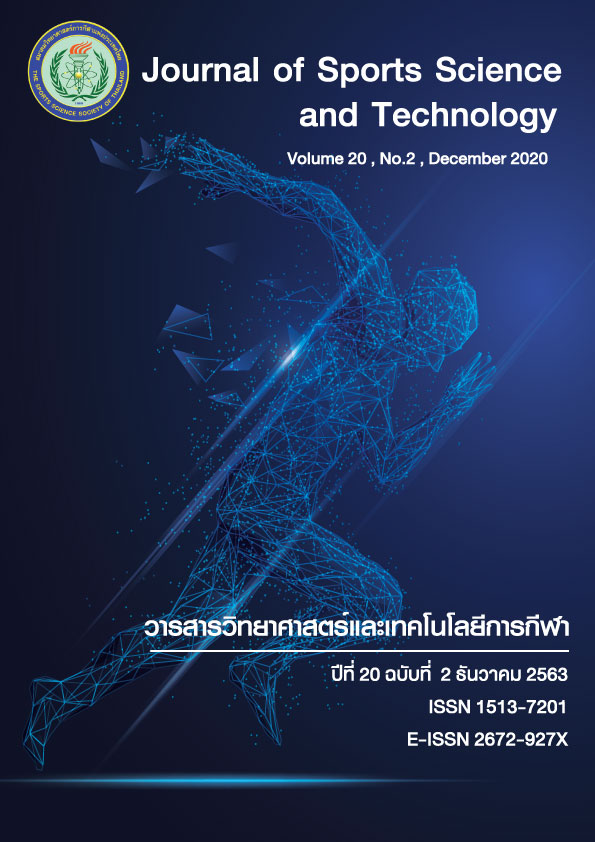ผลการประยุกต์ใช้จินตภาพประกอบดนตรีบรรเลงร่วมกับสุคนธบาบัดที่มีผลต่อการคลายตัว ของกล้ามเนื้อต้นขา และอัตราการเต้นของหัวใจในนักกีฬามหาวิทยาลัย
คำสำคัญ:
การจินตภาพ, สุคนธบาบัด, การจินตภาพที่มีดนตรีบรรเลง, เทคนิคการผ่อนคลายบทคัดย่อ
การวิจัยครั้งนี้มีวัตถุประสงค์เพื่อเปรียบเทียบผลการคลายตัวของกล้ามเนื้อต้นขา และอัตราการเต้นของหัวใจ จากการประยุกต์ใช้การจินตภาพที่มีดนตรีบรรเลงร่วมกับสุคนธบาบัด และการใช้การจินตภาพที่มีดนตรีบรรเลงในนักกีฬาระดับมหาวิทยาลัย กลุ่มตัวอย่างเป็นนิสิตที่เป็นนักกีฬาตัวแทนมหาวิทยาลัยที่อาสาสมัครเข้าร่วมการวิจัยจานวน 30 คน (เพศชาย 15 คน และเพศหญิง 15 คน) การสุ่มเพื่อเข้ากลุ่มจานวน 3 กลุ่ม (กลุ่ม ๆ ละ 10 คน) ใช้วิธีการสุ่มอย่างง่าย ประกอบด้วย 1. กลุ่มนั่งพัก 2. กลุ่มโปรแกรมการจินตภาพที่มีดนตรีบรรเลง และ 3. กลุ่มโปรแกรมการจินตภาพที่มีดนตรีบรรเลงร่วมกับสุคนธบาบัด เครื่องมือที่ใช้ในการทดลองประกอบด้วย เครื่องวัดสัญญาณป้อนกลับทางชีวภาพ โปรแกรม การจินตภาพร่วมกับดนตรีบรรเลงเพื่อการผ่อนคลาย จักรยานวัดงาน อุปกรณ์พ่นละอองไอน้าน้ามันหอมระเหยลาเวนเดอร์ เครื่องวัดอัตราการเต้นของหัวใจ การทดลองได้ออกแบบให้ผู้เข้าร่วมการทดลองออกกาลังกายด้วยการปั่นจักรยานวัดงาน กระทั่งมีอัตราการเต้นของหัวใจที่ร้อยละ 75 ของชีพจรสูงสุด จึงเข้ารับโปรแกรมการผ่อนคลาย ทั้ง 3 กลุ่ม เก็บรวบรวมข้อมูลโดยวัดผลก่อน-หลังการทดลอง และบันทึกผลทุก ๆ 4 นาที สถิติที่ใช้ในการวิเคราะห์ข้อมูล ได้แก่ ค่าเฉลี่ย (Mean) ค่าเบี่ยงเบนมาตรฐาน (Standard deviation) และวิเคราะห์ความแปรปรวนแบบหลายตัวแปร (Multivariate Analysis of Variance: MANOVA)
ผลการวิจัยพบว่า เมื่อทดสอบความแปรปรวนแบบหลายตัวแปรของทั้ง 3 กลุ่มพบว่าไม่มีความแตกต่างกัน และการทดสอบความแตกต่างภายในกลุ่มทดลองทั้ง 3 กลุ่มพบว่ามีความแตกต่างกันอย่างมีนัยสาคัญทางสถิติที่ระดับ
p< 0.05
(วารสารวิทยาศาสตร์และเทคโนโลยีการกีฬา 2563; 20(ฉบับออนไลน์))
คาสาคัญ: การจินตภาพ / สุคนธบาบัด / การจินตภาพที่มีดนตรีบรรเลง / เทคนิคการผ่อนคลาย
เอกสารอ้างอิง
2. Spielberger, C.D. Anxiety as an emotional state. In C.D. Spielberger (ed.), Anxiety and behavior. New York: Academy. Publication; 1972;3-44.
3. Cox, R.H. Sport psychology: concepts and applications. Dubuque, lowa: Wm.C.Brown. (Landers, 1983 cite in Gould, 2002). Publication; 1985;429.
4. Chatkamon, S. Sports Psychology. Faculty of Sport Science, Burapha Univesity. Publication; 2013.
5. Chatkamon, S. The Effect of Using Guided Imagery for Relaxation with three type of Music on Heart Rate, Electromyography (EMG) and time into a state of relaxation in Athletes. Journal of Sports Science and Technology. 2015;15(2):389-404.
6. Chanwit,I. Effects of Relaxing and Arousing Music during Imagery Training on Dart-Throwing Performance, Physiological Arousal Indices, and Competitive State Anxiety. Faculty of Sport Science, Burapha Univesity. Publication; 2016.
7. Prakongsiri, B. Aromatherapy. Retrieved 2017 March 1. from Website: http://elib.fda.moph.go.th/library/ default.asp?page2=subdetail&id_L1=27&id_L2=15518&id_L3=186.
8. Winai, S. Effects of selected volatile oils commonly used in Thailand on physiological activities and emotions. College of Public Health Sciences, Chulalongkorn University. Publication; 2011.
9. Thai Traditional Medicine, Indigenous Medicine and Alternative Medicine. Aromatherapy textbook. Bangkok. Publication; 2015.
10. Kanokwan, S., Opor, V., Nisit, P., Suwicha, M., Amporn, S. and Amporn, M. Effects of Aromatherapy on the change of Heart rate And the Effort value while exercising. Journal of Sports Science and Technology. 2006;6(2):115-126
11. Rouby, C., Schaal, B., Dubois, D., Gervais, R., and Holle, A. Olfaction, taste and cognition (Eds.). Cambridge: Cambridge University Press. 2002:140-159.
12. Hinton, P. B., & Henley, T. B. Cognitive and affective com-ponents of stimuli produced in three modes. Bulletin of the Psycho- nomic Society.1993;31:595-598.
13. Lorig, T. S., & Roberts, M.Odor and cognitive alteration of the contingent negative variation. Chemical Senses, 1990;15:537-545.
14. Power, S.K., & Howley, E.T. Exercise Physiology Theory and Application to Fitness and Performance
(6th ed.). Seoul: Life Science Publishing Co. Publication; 2001.
15. Issariya, T., Effect of Recovery after Exercise methods on Lactic acid in the Blood, Heart rate and Anaerobic Performance in Athletes. Faculty of Sport Science, Burapha Univesity. Publication; 2016.






